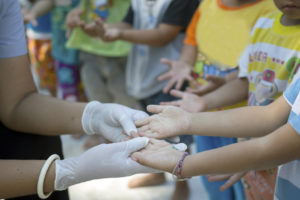
It’s normal for hand, foot and mouth disease to infect young children in early fall—but this year’s outbreak seems to be larger than last year’s.
Doctors at Forest Hills Pediatrics, a private practice in Grand Rapids, Michigan, saw 45 patients with HFM disease in the office in the past 60 days, according to William Bush, MD, a pediatrician at Forest Hills Pediatrics who is also pediatrician-in-chief at Spectrum Health Helen DeVos Children’s Hospital.
This number represents 2.2 percent of sick visits to the practice in that period. The office also received many phone calls about kids with the disease.
Over the same 60-day period in 2015, the number of patients seen with the disease was 25, or 1.1 percent of sick visits, according to Forest Hills Pediatrics data shared with Health Beat. Anecdotal evidence from another local private pediatrics practice suggested a similar trend.
West Michigan seems to be seeing “an increased HFM disease season than a year ago,” Dr. Bush said.
Look for lesions
The disease is a viral illness that starts with a fever and a sore throat, and a day or two later develops into blister-like lesions in the mouth. A rash also commonly appears on the hands and feet, though it can show up anywhere on the body.
Despite the spike in cases, there’s no real cause for concern, Dr. Bush said. This is a common illness among toddlers through elementary school-age students at this time of year. It typically runs its course quickly, without complications, though several years ago a more serious strain of the virus made the rounds.
“It takes usually two to five days from when you’re exposed to it to when you get it,” he said, “and then it’s usually gone within a week.”
The virus spreads easily through contact with the lesions or with a child’s stool or saliva—including through coughing or sneezing. So parents need to keep infected children home from school or daycare until the sores have healed.
People also need to be vigilant about hand-washing, said Daniel McGee, MD, a hospitalist with Helen DeVos Children’s Hospital.
“Wash your hands, wash your hands, wash your hands,” he said. “And if a child in your house is sick, don’t let him share toys with others before you clean them thoroughly.”
Older children and adults don’t typically contract the disease because they’ve developed immunity.
Keep kids hydrated
Treatment of the disease involves giving children plenty of fluids and providing pain medication if the lesions cause discomfort.
“If they’re refusing to eat or drink, that’s probably time to get (them to the doctor), because we need to assess whether they’re dehydrated,” Dr. Bush said.
Perhaps the worst part of this illness is that children can get it more than once in a season. There are 17 strains of the disease, Dr. Bush said, and even if children have had one strain, they can still pick up another.
“The unfortunate thing with little kids is that they swap an awful lot of germs,” he said. “They don’t wash their hands well, they stick their fingers into lots of places and touch a lot of items, and they get infections.”
The good news is that the hand, foot and mouth disease season is shorter than flu season, so families should be in the clear by Christmas.
 /a>
/a>
 /a>
/a>
 /a>
/a>